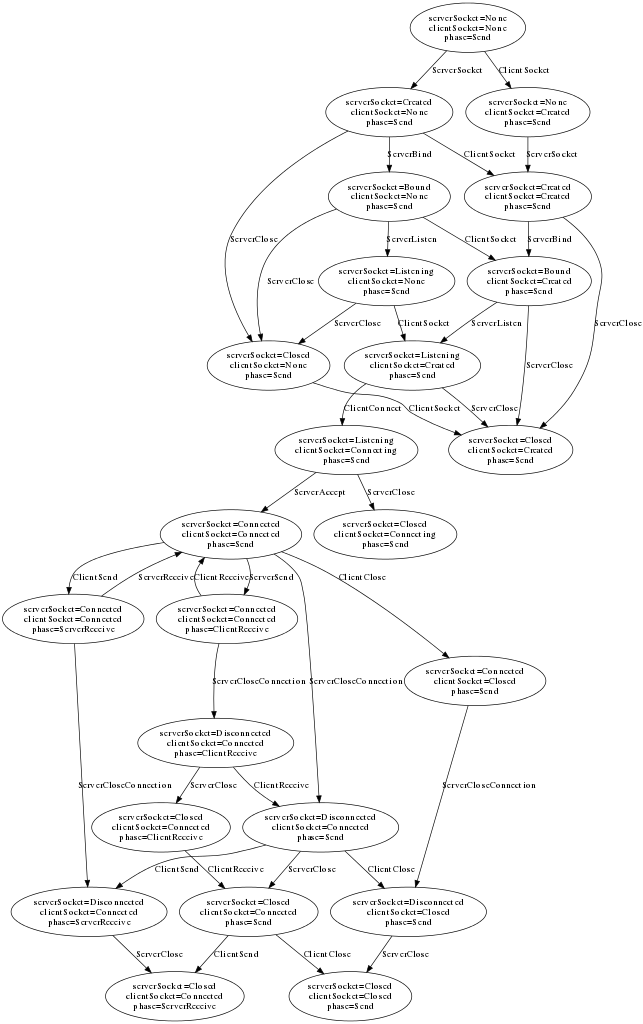The FsmFactory is inspired by the NModel project from Microsoft Research, https://nmodel.codeplex.com/, which later developed into the SpecExplorer. FsmFactory does only one thing: It creates a finite state chart from a class using the @Transition annotation.
The concept is:
- a class implements
Serializable. - Annotates methods that represents transitions using the
@Transition. A transition is when some state changes. Some properties are changing values. - In a stateful system, transitions are only allowed under certain circumstances. This is done by accompanying guard methods to the transition method. They share the same method name, except that the guard has a the word
Onprefixed to the name.
Consider following code: (See also book Model-based Software Testing and Analysis with C#, the example with Client and Server. http://www.cambridge.org/se/academic/subjects/computer-science/software-engineering-and-development/model-based-software-testing-and-analysis-c?format=PB)
FsmFactory factory = new FsmFactory();
Model model = factory.create(new ClientServer());
System.out.println(DotFileFactory.createDot(model));and where the ClientServer class looks like:
public class ClientServer implements Serializable {
public enum Socket { None, Created, Bound, Listening, Connecting,
Connected, Disconnected, Closed }
public enum Phase { Send, ServerReceive, ClientReceive }
// Control state
public Socket serverSocket = Socket.None;
public Socket clientSocket = Socket.None;
public Phase phase = Phase.Send;
// Server enabling conditions and actions
public boolean OnServerSocket() {
return (serverSocket == Socket.None);
}
@Transition
public void ServerSocket() {
serverSocket = Socket.Created;
}
public boolean OnServerBind() {
return (serverSocket == Socket.Created);
}
@Transition
public void ServerBind()
{
serverSocket = Socket.Bound;
}
public boolean OnServerListen()
{
return (serverSocket == Socket.Bound);
}
@Transition
public void ServerListen()
{
serverSocket = Socket.Listening;
}
public boolean OnServerAccept()
{
return (serverSocket == Socket.Listening
&& clientSocket == Socket.Connecting);
}
@Transition
public void ServerAccept()
{
serverSocket = Socket.Connected; clientSocket = Socket.Connected;
}
public boolean OnServerReceive()
{
return (serverSocket == Socket.Connected
&& phase == Phase.ServerReceive);
}
// No parameter needed here, client always sends same thing
@Transition
public void ServerReceive()
{
phase = Phase.Send;
}
public boolean OnServerSend()
{
return (serverSocket == Socket.Connected
&& phase == Phase.Send
&& clientSocket == Socket.Connected);
}
// Parameter here, server can send different temperatures
@Transition
public void ServerSend()
{
phase = Phase.ClientReceive;
}
public boolean OnServerCloseConnection()
{
return (serverSocket == Socket.Connected);
}
@Transition
public void ServerCloseConnection()
{
serverSocket = Socket.Disconnected;
}
// Prevent Client crashing - does sending to closed partner crash?
public boolean OnServerClose()
{
return (serverSocket != Socket.None
// && serverSocket != Socket.Listening
&& serverSocket != Socket.Connected
&& serverSocket != Socket.Closed);
}
@Transition
public void ServerClose()
{
serverSocket = Socket.Closed;
}
// Client enabling conditions and actions
public boolean OnClientSocket()
{
return (clientSocket == Socket.None);
}
@Transition
public void ClientSocket()
{
clientSocket = Socket.Created;
}
public boolean OnClientConnect()
{
return (clientSocket == Socket.Created
&& serverSocket == Socket.Listening);
}
@Transition
public void ClientConnect()
{
clientSocket = Socket.Connecting;
}
public boolean OnClientSend()
{
return (clientSocket == Socket.Connected
&& phase == Phase.Send);
}
// No parameter needed here, client always sends the same thing
@Transition
public void ClientSend()
{
phase = Phase.ServerReceive;
}
public boolean OnClientReceive()
{
return (clientSocket == Socket.Connected
&& phase == Phase.ClientReceive);
}
// Return value needed here, server sends different values
@Transition
public void ClientReceive()
{
phase = Phase.Send;
}
public boolean OnClientClose()
{
return (clientSocket == Socket.Connected
&& phase == Phase.Send);
}
@Transition
public void ClientClose() {
clientSocket = Socket.Closed;
}
}The FsmFactory will create a state chart, when written and visialized by graphviz and dot, will look like:
(using dot -Tsvg clientserver.dot > login.svg)
